Related Research Articles

A Masonic lodge, often termed a private lodge or constituent lodge, is the basic organisational unit of Freemasonry. It is also commonly used as a term for a building in which such a unit meets. Every new lodge must be warranted or chartered by a Grand Lodge, but is subject to its direction only in enforcing the published constitution of the jurisdiction. By exception the three surviving lodges that formed the world's first known grand lodge in London have the unique privilege to operate as time immemorial, i.e., without such warrant; only one other lodge operates without a warrant – the Grand Stewards' Lodge in London, although it is not also entitled to the "time immemorial" title. A Freemason is generally entitled to visit any lodge in any jurisdiction in amity with his own. In some jurisdictions this privilege is restricted to Master Masons. He is first usually required to check, and certify, the regularity of the relationship of the Lodge – and be able to satisfy that Lodge of his regularity of membership. Freemasons gather together as a Lodge to work the three basic Degrees of Entered Apprentice, Fellowcraft, and Master Mason.
The history of Freemasonry encompasses the origins, evolution and defining events of the fraternal organisation known as Freemasonry. It covers three phases. Firstly, the emergence of organised lodges of operative masons during the Middle Ages, then the admission of lay members as "accepted" or "speculative" masons, and finally the evolution of purely speculative lodges, and the emergence of Grand Lodges to govern them. The watershed in this process is generally taken to be the formation of the first Grand Lodge in London in 1717. The two difficulties facing historians are the paucity of written material, even down to the 19th century, and the misinformation generated by masons and non-masons alike from the earliest years.
In Freemasonry, regularity is one of the factors by which individual Grand Lodges judge whether to recognise one another for the purposes of allowing formal interaction at the Grand Lodge level and visitation by members of other jurisdictions. Each individual Grand Lodge determines which other Grand Lodges it considers Regular.

The Grand Orient de France (GODF) is the oldest and largest of several Freemasonic organizations based in France and is the oldest in Continental Europe. The Grand Orient de France is generally regarded as the "mother lodge" of Continental Freemasonry.
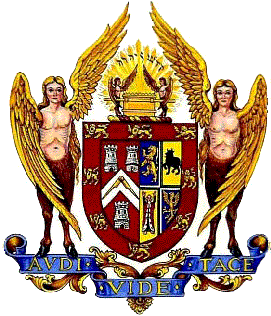
The United Grand Lodge of England (UGLE) is the governing Masonic lodge for the majority of freemasons in England, Wales and the Commonwealth of Nations. Claiming descent from the Masonic grand lodge formed 24 June 1717 at the Goose & Gridiron Tavern in London, it is considered to be the oldest Masonic Grand Lodge in the world. Together with the Grand Lodge of Scotland, and the Grand Lodge of Ireland, they are often referred to by their members as "the home Grand Lodges" or "the Home Constitutions".
Prince Hall Freemasonry is a branch of North American Freemasonry for African Americans founded by Prince Hall on September 29, 1784. There are two main branches of Prince Hall Freemasonry: the independent State Prince Hall Grand Lodges, most of which are recognized by Mainstream grand lodges, and those under the jurisdiction of the National Grand Lodge. Prince Hall Freemasonry is the oldest and largest predominantly African-American fraternity in the nation.

Freemasonry in Malta has a lengthy history dating from the eighteenth century. The main masonic influences have been from the United Grand Lodge of England, the Grand Lodge of Scotland, and the Grand Lodge of Ireland. Today Regular Freemasonry is under the jurisdiction of the Sovereign Grand Lodge of Malta, formed in 2004.
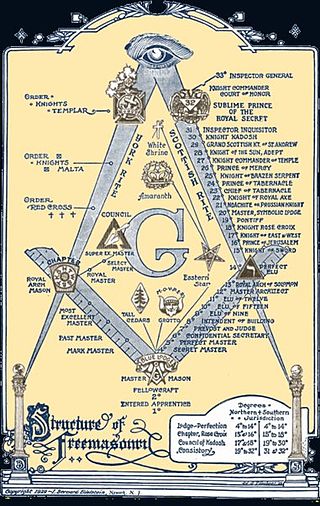
There are many organisations and orders which form part of the widespread fraternity of Freemasonry, each having its own structure and terminology. Collectively these may be referred to as Masonic bodies, Masonic orders or appendant bodies of Freemasonry.
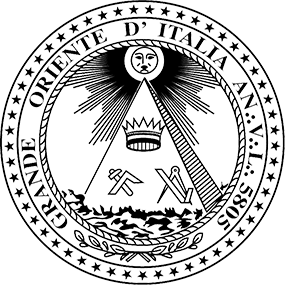
The Grand Orient of Italy (GOI) is an Italian masonic grand lodge founded in 1805; the viceroy Eugene of Beauharnais was instrumental in its establishment. It was based at the Palazzo Giustiniani, Rome, Italy from 1901 until 1985 and is now located at the Villa del Vascello. Its current Grand Master is Italian journalist Stefano Bisi.
This is a general survey on the historical and modern presence of Freemasonry in countries located in Asia.
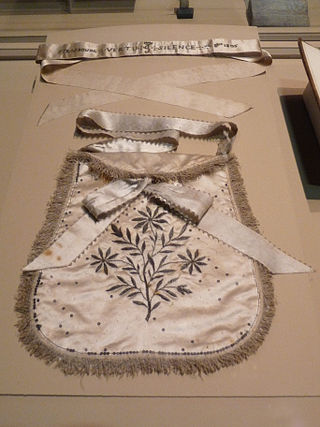
Freemasonry has had a complex relationship with women, which can be readily divided into many phases with no demonstrable relationship to each other until the 20th century. A few women were involved in Freemasonry before the 18th century; however the first printed constitutions of the Premier Grand Lodge of England appeared to bar them from the Craft forever.
Freemasonry in Denmark was first established in 1743 and is today represented by a number of Grand Lodges. The oldest and biggest Masonic Grand Lodge in Denmark is the Danish Order of Freemasons, in English also known as the Grand Lodge of Denmark.

This is a chronology of the formation of "regular" or "mainstream" Masonic Grand Lodges in North America, descending from the Premier Grand Lodge of England or its rival, the Antient Grand Lodge of England. A Grand Lodge is the governing body that supervises "Craft" Freemasonry in a particular jurisdiction or geographical area.
Continental Freemasonry, otherwise known as Liberal Freemasonry, Latin Freemasonry, and Adogmatic Freemasonry, includes the Masonic lodges, primarily on the European continent, that recognize the Grand Orient de France (GOdF) or belong to CLIPSAS, SIMPA, TRACIA, CIMAS, COMAM, CATENA, GLUA, or any of various other international organizations of Liberal, i.e. Continental Freemasonry. The larger number of Freemasons, most of whom live in the United States–where Regular Freemasonry holds a virtual monopoly–belong to Masonic lodges that recognize the United Grand Lodge of England and do not recognize Continental Freemasons, regarding them as "irregular".
A Research lodge is a particular type of Masonic lodge which is devoted to Masonic research. It is a lodge, and as such has a charter from some Grand Lodge. However, it does not confer degrees, and restricts membership to Master Masons of some jurisdiction in amity with the jurisdiction that the research lodge is in. Related to research lodges are Masonic research societies, which serve the same purpose but function fundamentally differently. There are research lodges in most countries where Freemasonry exists.
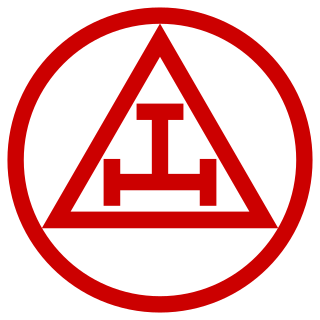
Royal Arch Masonry is the first part of the American York Rite system of Masonic degrees. Royal Arch Masons meet as a Chapter, and the Royal Arch Chapter confers four degrees: Mark Master Mason, Past Master, Most Excellent Master, and Royal Arch Mason.
Continental Freemasonry in North America is relatively rare, but there are a few continental-style organizations active.

The Grand Lodge of Cyprus, or in the Greek language, Μεγάλη Στοά της Κύπρου, is the sovereign governing body of freemasonry within the Republic of Cyprus. Its formal English name is "The Most Worshipful Grand Lodge of Cyprus, Ancient Free and Accepted Masons." While four of its constituent lodges are approaching 100 years of age, the Grand Lodge of Cyprus itself came into being on February 15, 2006. Thus it is one of the youngest grand lodges in the world.
References
- ↑ "United Grand Lodge of England - Foreign Grand Lodges". www.ugle.org.uk. Archived from the original on 22 October 2013. Retrieved 4 March 2018.
- ↑ "HOME > West Virginia Grand Lodge AF & AM". West Virginia Grand Lodge AF & AM. Retrieved 4 March 2018.
- ↑ "PARKERSBURG, WEST VIRGINIA: The Masonic Home". electricearl.com. Retrieved 4 March 2018.
- ↑ Baucher, Todd (9 January 2017). "Commission discusses future uses for West Virginia Masonic Home" . Retrieved 4 March 2018.
- ↑ The Formation of the Grand Lodge Archived 2016-06-17 at the Wayback Machine from "A Century of Freemasonry", hosted by the West Virginia Grand Lodge
- 1 2 ""Interesting Masonic Event to be Observed". The Gazette Times. April 10, 1915. from Google News.
- ↑ A History of Monroe County, West Virginia
- 1 2 Denslow, William R. "10,000 Famous Freemasons, vol. 1".
- ↑ Cotner, Robert (2011-03-04). "Osiris Noble Frank Buckles, Eldest Shriner, Dies in West Virginia" (PDF). Shrinelines. Archived from the original (PDF) on 2012-03-21.
- ↑ Javers, Eamon (September 28, 2009). "In search of the Hill's Freemasons". Politico . Retrieved 2010-01-12.
- ↑ Beverly, Steve and Chris Tufts. "First-Ever Central Character On "To Tell The Truth" Dies At 86". Daily Game Show Fix.
- ↑ Denslow, William R. "10,000 Famous Freemasons, vol. 4".
- ↑ "Remarks Of The Grand Master Of Masons In West Virginia". West Virginia State Division of Culture and Heritage. Retrieved May 24, 2016.
- 1 2 Clevenger, Andrew (June 9, 2008). "Judge sues W.Va. Masons". Charleston Gazette-Mail. Archived from the original on June 10, 2008.
{{cite news}}: CS1 maint: unfit URL (link) - 1 2 3 Caswell, Cheryl (December 16, 2010). "Jury finds Masons not guilty in case". Charleston Gazette-Mail . Retrieved May 22, 2016.
- 1 2 3 Barry, Dan (16 June 2008). "From Would-Be Reformer, to Former Mason, to Plaintiff". New York Times .
- 1 2 "Expelled Mason in W.Va. sues grand master, lodge". The Herald-Dispatch . Associated Press. June 9, 2008.
- ↑ Ry Rivard (December 3, 2010). "Jury to be selected in Masonic law case". Charleston Gazette-Mail.
- ↑ Christopher Hodapp (December 15, 2010). "Verdict in Haas vs. Grand Lodge of West Virginia AF&AM".
- ↑ Milliken, Fred (February 13, 2013). "PGM Frank Haas Alleged to Have Been Expelled From the Grand Lodge of Ohio Who Previously Granted Him Asylum". Freemason Information. Retrieved May 22, 2016.

